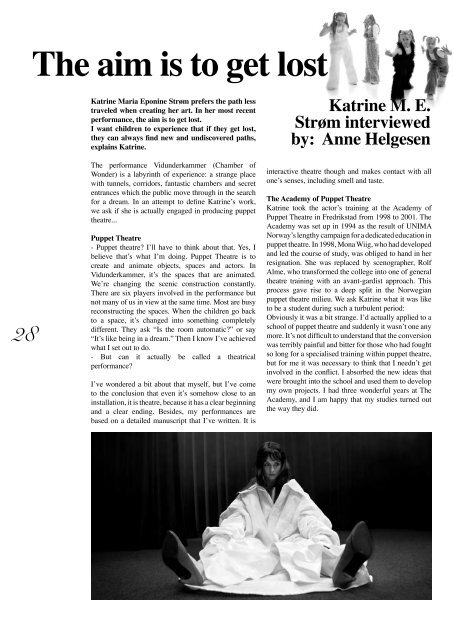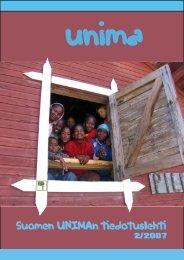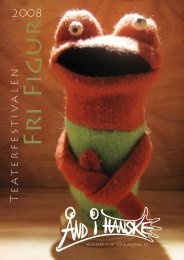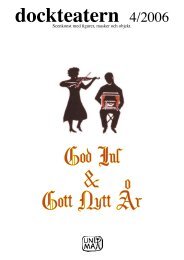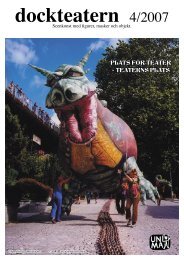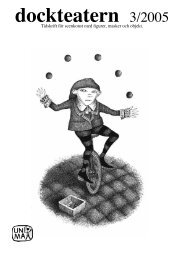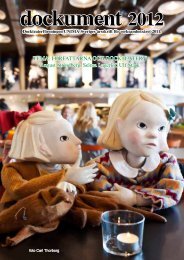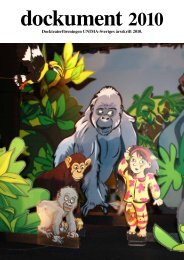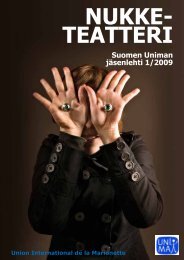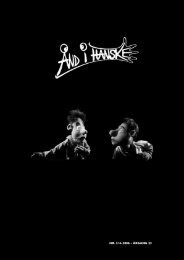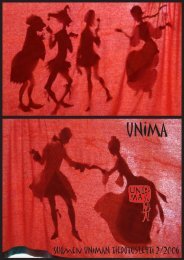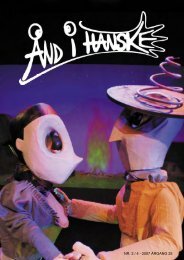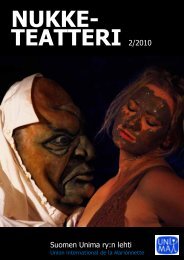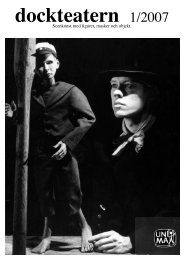The aim is to get lost28Katrine Maria Eponine Strøm prefers the path lesstraveled when creating her art. In her most recentperformance, the aim is to get lost.I want children to experience that if they get lost,they can always find new and undiscovered paths,explains Katrine.The performance Vidunderkammer (Chamber ofWonder) is a labyrinth of experience: a strange placewith tunnels, corridors, fantastic chambers and secretentrances which the public move through in the searchfor a dream. In an attempt to define Katrine’s work,we ask if she is actually engaged in producing puppettheatre...Puppet Theatre- Puppet theatre? I’ll have to think about that. Yes, Ibelieve that’s what I’m doing. Puppet Theatre is tocreate and animate objects, spaces and actors. InVidunderkammer, it’s the spaces that are animated.We’re changing the scenic construction constantly.There are six players involved in the performance butnot many of us in view at the same time. Most are busyreconstructing the spaces. When the children go backto a space, it’s changed into something completelydifferent. They ask “Is the room automatic?” or say“It’s like being in a dream.” Then I know I’ve achievedwhat I set out to do.- But can it actually be called a theatricalperformance?I’ve wondered a bit about that myself, but I’ve cometo the conclusion that even it’s somehow close to aninstallation, it is theatre, because it has a clear beginningand a clear ending. Besides, my performances arebased on a detailed manuscript that I’ve written. It isKatrine M. E.Strøm interviewedby: Anne Helgeseninteractive theatre though and makes contact with allone’s senses, including smell and taste.The Academy of Puppet TheatreKatrine took the actor’s training at the Academy ofPuppet Theatre in Fredrikstad from 1998 to 2001. TheAcademy was set up in 1994 as the result of <strong>UNIMA</strong>Norway’s lengthy campaign for a dedicated education inpuppet theatre. In 1998, Mona Wiig, who had developedand led the course of study, was obliged to hand in herresignation. She was replaced by scenographer, RolfAlme, who transformed the college into one of generaltheatre training with an avant-gardist approach. Thisprocess gave rise to a deep split in the Norwegianpuppet theatre milieu. We ask Katrine what it was liketo be a student during such a turbulent period:Obviously it was a bit strange. I’d actually applied to aschool of puppet theatre and suddenly it wasn’t one anymore. It’s not difficult to understand that the conversionwas terribly painful and bitter for those who had foughtso long for a specialised training within puppet theatre,but for me it was necessary to think that I needn’t getinvolved in the conflict. I absorbed the new ideas thatwere brought into the school and used them to developmy own projects. I had three wonderful years at TheAcademy, and I am happy that my studies turned outthe way they did.
The NorthernerKatrine M. E. Strøm runs the independent theatre,Katma, in the small village of Dverberg on Andøya inNorth Norway. She is a promising, young artist, barelythirty years old. One of the many surprising thingsabout her is her insistence on her allegiance to Outof-the-wayNorway. As far back as 1993, she was theamateur director of the children’s and student theatre inher home village. In other words, the divide betweenyouthful amateurism and professional practitionerdoesn’t seem to bother her at all. Her work withyoungsters bears no signs of stammering kids moreor less trying to copy ’traditional adult theatre’. Whatcomes into being instead are original performanceswhich incorporate children’s ways of thinking andmoving into a structure and framework which carriesKatrine Strøm’s professional artistic signature. Katrineis a hero in her local community where nearly all thechildren and young adults have been involved in theatreunder her leadership.Theatre on children’s termsKatrine brings children into her professional productionstoo. Mette Spjelkavik Enoksen has been in Katma’s last5 productions. She was 6 when she first took part; nowshe’s 11. Mette goes out on tour too, so Katrine has tofulfil the role of schoolteacher as well as director andperformer. It’s a job she’s more than happy to take on.Having children as performers is an important elementin the way she thinks about theatre:- I can see what it means to an audience of children tohave a child taking part in the performance. For me, achild stands for innocence and honesty. Children havesomething unused and inexperienced about them whichI find fascinating. In my productions, I always try tograsp children’s ways of thinking and experiencing.We always work very closely with a reference groupof children throughout the whole process. When Iwas a child, I bored myself stupid at the theatre. NowI want to make theatre on children’s own terms. Butthat doesn’t mean I want to make commercial theatre.Children today get far too much of that kind of thing.I want to make theatre which touches them deeply. Iwant to take children seriously.Katrine is an artistic director, actor and producer. Since1995 she has been swapping back and forth betweenstudying and working with a host of productions inthe local community and in a <strong>Nordic</strong> and internationalcontext. In 2004, she was the mainspring, producerand director of an exchange project for young artistsin Norway, Iceland and Faroe Islands resulting in theproduction ’Stille Øy’ (Silent Island). All the same, forthe moment children’s theatre is first and foremost herchosen arena. So much is it children’s theatre, in fact,that her performances are prohibited to adults.- The children are really happy about that. They needto have some experiences of their very own whereadults don’t interfere. The adults, of course, are verydisappointed about not being allowed to join in,explains Katrine.Katma’s 2003 production, Sukker Sirkus (SugarCircus) takes only 20 audience members at a time;Vidunderkammer has room for 30. These childrenconstitute an exclusive group and the ticket-price perhead is expensive. Fortunately for Katma, both theNorwegian national cultural authorities and NordlandPuppet Theatre lend their support.Nordland Puppet TheatreThe Nordland Puppet Theatre started its life under thename of the Nordland Puppet Theatre Workshop in 1991.Preben Faye-Schjøll is the current artistic director forthe production house which lies in Stamsund, Lofoten,not far from Andøya and Dverberg. Faye-Schjøll hasincurred the wrath of much of the Norwegian puppettheatre milieu by stating that Norwegian puppeteersare not good enough to be allowed to produce theirperformances at Stamsund. Over a three year periodhe has reserved the right only to subsidise foreignproductions at the theatre in Stamsund. In 2007 thismeant the Italian Paolo Nani Teater with Brainwash,American Wakka, Wakka with Factory and SwedishFel Scen with Snow White. The only exception to thisrule was Katma. Vindunderkammer was produced atNordland Puppet Theatre last year.Three of Katma’s shows have been produced at theStamsund house. Preben Faye-Schjøll was Katrine’sinstructor as far back as when she was studying at theacademy in Fredrikstad.- Nordland Puppet Theatre has been a fantastic place forme, says Katrine. Firstly, just to get to work in Lofoten;29


